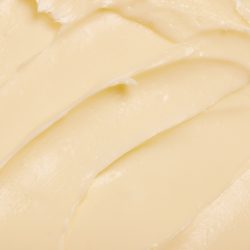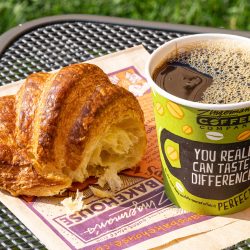Through October, we’re writing a series of blog posts spotlighting our new partnership with Vermont Creamery and how their award-winning Cultured Butter is elevating our baking game in the Bakehouse Pastry Kitchen to new heights of richness, flavor complexity, and texture. Since we began baking with their butter, our laminated pastries, scones, and all-butter pie crusts are flakier, our coffee cakes are richer and more tender, and they’re all chock full of complex flavor with good shape and structure that only cultured butter with 82% butterfat can bring. Head to our first blog post of the series to learn more about Vermont Creamery, our partnership, and why we love their Cultured Butter.
For the second installment of the series, we’re delving into the step-by-step process by which Vermont Creamery sources fresh, cow’s milk cream from local, family dairy farms and how they then transform it into their award-winning Cultured Butter.
Local Sourcing of Fresh Cow’s Milk Cream Through the St. Albans Cooperative
Through the St. Albans Cooperative, Vermont Creamery sources all the fresh cow’s milk cream that goes into their cultured butter from local, multi-generational family dairy farms, with herds averaging around 100 milking cows at each farm. St. Albans Cooperative Creamery in St. Albans, Vermont, was formed in 1919 by a group of Vermont dairy farmers that came together to provide markets for its members’ milk. Since then, the Cooperative has been working steadily to ensure a stable milk market, competitive prices, and valuable farm services for its family farm-owner members. In 2019, following a strategic planning process, the members of St. Albans Cooperative voted to successfully merge with its long-time partner, Dairy Farmers of America (DFA).
Vermont Creamery’s Butter-Making Process
The wonderful butter makers at Vermont Creamery shared with us the six-step process for making their award-winning cultured butter:

Step 1 (Vat Pasteurization):
Cultured butter is made with fresh, pasteurized cream just like regular sweet cream butter. Fresh Vermont cow’s milk cream with 40% butterfat is received at Vermont Creamery, from the St. Alban’s Cooperative, and pasteurized at a lower temperature than the standard Hi-Temp Thermal Pasteurization used for AA Sweet Cream Butter to maintain the full flavor of the cream.

Step 2 (Cream Culturing):
After the cream is pasteurized, our expert butter makers add live bacterial cultures, which is what differentiates cultured butter from traditional sweet cream butter. The cream rests in a vat while thickening, where it develops complex flavor notes of buttermilk and hazelnuts. We ferment the cream slowly overnight to produce the best flavors and aromas. Culturing produces the flavor compound “Diacétyl”, or what we think of as “butter flavor”; this is why traditionally cultured butter tastes extra buttery! Making cultured butter is much like making fine wine, you want to ferment your cream like your grapes, slowly, to produce the best aromas and flavors.

Step 3 (Cream Cooling):
The cream is slowly cooled before being transferred to the churn. This step is essential for giving the fat ample time to crystallize, a step pivotal to providing the pliability and consistency needed for technical baking.

Step 4 (Churning):
The cooled and fermented cream is added to the mechanical churn, at which point it is churned vigorously to agitate and break the fat globules, causing them to coalesce and separate from the buttermilk.
The mechanical action of churning disrupts the gel-like network formed by the casein micelles, releasing fat globules that cluster together to form the “butter mass”. Churning is a critical step in getting the butter just right. It’s where the majority of the buttermilk is removed, while saving all of that delicious fat. It is a perfect balance of cream input speed, beaters, and moving the captured fat along in the process.

Step 5 (Butter Working):
The remaining “butter mass” is moved to the second working section of the churn where we’ve separated out all the buttermilk to the exact moisture, fat, and salt levels (in salted butter).
This final stage of working the butter provides uniform texture and distributes salt evenly. It is then sent to the “boat,” for the final stage.
Step 6 (Forming and Packaging):
Finally, the butter is transferred to the “boat,” where it changes from a noodle-like state to its final butter form. Consistent back-pressure from the churn facilitates this transformation, achieved by tapering down from the churn to the boat. The boat’s purpose is to build up a consistent butter mass, which is then sent to the fillers for packaging. The butter is packed in either 1 lb rolls or bulk 25 kg cases.
Come on in for a taste!
After a long, established career as a Ph.D. art history scholar and art museum curator, Lee, a Michigan native, came to the Bakehouse in 2017 eager to pursue her passion for artisanal baking and to apply her love of history, research, writing, and editing in a new exciting arena. Her first turn at the Bakehouse was as a day pastry baker. She then moved on to retail sales in the Bakeshop, followed by joining the Marketing Team and becoming the Bakehouse’s designated culinary historian. In addition to her retail sales and marketing work, she’s a member of the Bakehouse’s Grain Commission, co-author and editor of the Bakehouse's series of cookbooklets, and a regular contributor to the BAKE! Blog and Zingerman’s Newsletter, where she explores the culinary, cultural, and social history and evolution of the Bakehouse’s artisan baked goods.



HELLO,
Thank-you for the butter information. Is the butter considered lactose free?
Cheryl
Hi Cheryl, it is not lactose-free. Thanks for the question.